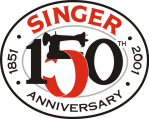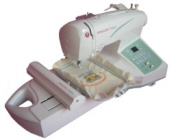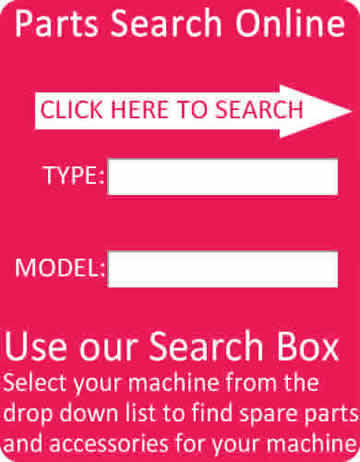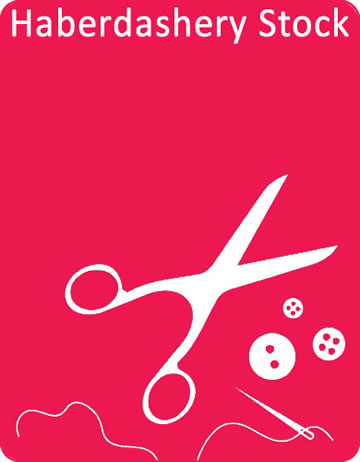| |
| |
| 1811 |
Issac Merritt Singer was born in Schaghiticoke, New York.
|
|
| |
| |
| 1850 |

Orson C. Phelps of Boston was manufacturing sewing machines under license from John A. Lerow. The Lerow and Blodgett machine was not very practical. The circular movement of the shuttle took a twist out of the thread at every revolution.
Isaac Merritt Singer, after examining the machine, noted "instead of the shuttle going around in a circle, I would have it move to and fro in a straight line. In place of the needle bar pushing a curved needle horizontally, I would have a straight needle and make it work up and down."
After 11 days and $40 in cost, Singer completed his invention: the world's first practical sewing machine. This machine had a straight eye-pointed needle and transverse shuttle, an overhanging arm, a table to support the cloth, a presser foot to hold the material against the upward stroke of the needle, and a roughened feed wheel extending through a slot in the table. Motion was communicated to the needle arm and shuttle by means of gears.
Singer also conceived the idea of using a treadle similar to that of a spinning wheel; all other machines at the time used a hand crank to generate power.
|
|
| |
| |
| 1851 |

Isaac Merritt Singer formed I.M. Singer & Company with New York lawyer Edward C. Clark, following Singer's first lockstitch sewing machine patent. The Singer Sewing Machine was for sale all over the United States. Within two years Singer was the leading manufacturer and marketer of sewing machines in the United States.
|
|
| |
| |
| 1852 |
Singer patented a tension device.
|
|
| |
| |
| 1853 |

I. M. Singer & Co. set up corporate offices and a manufacturing facility in New York City. Company is renamed "Singer Manufacturing Company".
The first Singer sewing machines, manufactured in New York, sell for $100 each.
|
|
| |
| |
| 1855 |

Singer became the world's largest sewing company. Singer beganoverseas expansion, starting in Paris, France, making Singer the world’s first international company.
A Singer sewing machine was awarded a first prize at the World's Fair in Paris.
|
|
| |
| |
| 1856 |

Edward Clark originated the hire-purchase plan, the prototype for all installment selling or time payment purchases. As a result, individuals with even meager income could own a Singer sewing machine. Even better, they could increase their productivity, earn more money and improve their position in life.
The "Turtleback" sewing machine was introduced.
Singer patented a ruffler, tucker and binder.
Branch office opened in Glasgow, Scotland.
|
|
| |
| |
| 1857 |

First Singer showroom and headquarters located at 458 Broadway, New York City.
|
|
| |
| |
| 1858 |

The first lightweight domestic machine, the "Grasshopper," was introduced.
Unit sales topped 3,000 a year.
Singer opened three manufacturing plants in New York City.
Singer opens an operation in Brazil.
|
|
| |
| |
| 1859 |

Singer received first of three patents for lock-stitch vibrating shuttle machines.
|
|
| |
| |
| 1861 |
Foreign sales exceed U.S. sales for the first time.
|
|
| |
| |
| 1863 |

The company was incorporated as the Singer Manufacturing Company, holding 22 patents and with capital assets of $550,000. Some 20,000 home sewing machines were being sold annually.
Branch office opened in Hamburg, Germany.
|
|
| |
| |
| 1865 |

The "New Family" sewing machine was introduced.
|
|
| |
| |
| 1866 |
Singer patented an oscillating shuttle sewing machine.
|
|
| |
| |
| 1867 |
Singer opened it's first factory outside of the United States in Glasgow, Scotland.
|
|
| |
| |
| 1868 |
Cabinet factory opened in South Bend, Indiana.
|
|
| |
| |
| 1870 |

The Singer Company sells 170,000 machines.
The Singer Manufacturing Company opened sales and distribution centers in England.
The Singer Red “S” girl trademark made her debut. Her trademark is produced in several languages, becoming one of the most recognized trademarks in the world.
|
|
| |
| |
| 1870 |

Red "S" girl trademark made her debut-destined to become one of the best-known emblems in the world.
|
|
| |
| |
| 1871 |
Singer's Bridgton factory became the largest in Britain.
Unit sales reached 180,000 a year.
|
|
| |
| |
| 1872 |

Elizabethport, New Jersey became the site of a large, state-of-the-art manufacturing facility.
|
|
| |
| |
| 1873 |
With the official opening of the factory in Elizabethport, the Singer Manufacturing Company became a New Jersey Corporation under a special charter.
Canadian manufacturing began.
|
|
| |
| |
| 1875 |
I.M. Singer dies in Torquay, England at age 63.
|
|
| |
| |
| 1880 |
An Edison electric motor drives a sewing machine.
Singer sewing machine sales worldwide exceed 500,000 machines. Additional factories are established in the United States.
|
|
| |
| |
| 1881 |
Factory opened in Cairo, Illinois.
|
|
| |
| |
| 1882 |
Factories opened in Montreal, Quebec, Canada and Floridsdorf, Austria.
|
|
| |
| |
| 1883 |

To meet growing demand in Europe, Singer opened the largest sewing machine factory in the world in Kilbowie, Scotland. The factory at one point employed 12,000 workers and it's most distinctive feature was the second largest clock tower in the world at almost 200 feet high.
|
|
| |
| |
| 1884 |

The Statue of Liberty is believed to be in Isabella Singer's likeness, was given to the U.S.
|
|
| |
| |
| 1889 |
Singer introduced the first practical electric sewing machine.
|
|
| |
| |
| 1890 |

Singer claimed 80% worldwide market share in sewing machines.
|
|
| |
| |
| 1891 |
First use of electric motor to power a commercial machines.
|
|
| |
| |
| 1892 |
Singer developed a commercial zigzag machine.
|
|
| |
| |
| 1900 |

Singer Company produced 40 different sewing machine models.
The "Singer 66" was introduced.
Kilbowie, Scotland factory renamed Clydebank.
|
|
| |
| |
| 1902 |
Factory opened in Podolsk, Russia.
|
|
| |
| |
| 1903 |
Annual sales reach 1.35 million machines worldwide.
|
|
| |
| |
| 1904 |

New factories opened in Wittenberge, Prussia and St. John's, Quebec, Canada.
Russian corporate headquarters opened. It was Russia's first steel girder structure.
The Singer Sewing Machine Company became the sales and distribution division of Singer Manufacturing Company.
|
|
| |
| |
| 1905 |
Singer acquired "Wheeler and Wilson Manufacturing Company".
|
|
| |
| |
| 1907 |
Factory opened in Bridgeport, Connecticut.
|
|
| |
| |
| 1908 |

The Singer Building at 149 Broadway in New York City opens. At the time of it's completion, it was the first skyscraper and the tallest building in the world, standing at 47 stories, 612 feet tall. It was headquarters for the Executive Office for 54 years.
|
|
| |
| |
| 1913 |
Singer sales reached 3 million machines worldwide.
|
|
| |
| |
| 1921 |

Singer introduced the "Portable Electric," an electric-motor powered model 99K.
|
|
| |
| |
| 1927 |

First Singer Sewing Center to offer sewing courses, was introduced to New York City.
|
|
| |
| |
| 1929 |
Nine worldwide Singer manufacturing facilities exist, employing 27,000 people and producing 3,000 models.
Singer purchased the Standard Sewing Machine Company.
First vacuum cleaner introduced, launching Singer’s strategy of diversification beyond sewing machines.
|
|
| |
| |
| 1933 |

Singer introduced its "Featherweight" at the Chicago's World Fair.
Factories opened in Monsa, Italy and Bounieres, France.
|
|
| |
| |
| 1949 |
Singer developed "Model 95K", capable of 4,000 stitches per minute.
|
|
| |
| |
| 1950 |
Plant opened in Anderson, South Carolina.
|
|
| |
| |
| 1951 |

The Singer Sewing Center trained an estimated 400,000 housewives.
Singer recovered from World War II when sewing machine production was suspended, reaching $307.8 million in sales during it's centennial year.
|
|
| |
| |
| 1952 |
 Singer introduced the model 206, it's first zigzag machine. Singer introduced the model 206, it's first zigzag machine. |
|
| |
| |
| 1955 |
New factory in Campinas, Brazil opened.
|
|
| |
| |
| 1957 |
Annual sales reached $359 million.
|
|
| |
| |
| 1958 |
Annual sales reached $507 million.
|
|
| |
| |
| 1960 |
Singer began diversification. In the following years, the company will make acquisitions in electric, electric test equipment and office machinery, including Packard Bell Electronics (1966) and General Precision Equipment Corporation (1968).
|
|
| |
| |
| 1961 |
Executive Office moved to 30 Rockefeller Plaza, New York City.
|
|
| |
| |
| 1963 |
The Singer Manufacturing Company changed it's name to "The Singer Company."
|
|
| |
| |
| 1965 |

Singer introduces the "Touch and Sew" sewing machines.
Consolidated sales reached $979.8 million.
|
|
| |
| |
| 1966 |
Consolidated sales reached the billion-dollar mark for the first time.
|
|
| |
| |
| 1970 |
Sales first topped $2 billion.
|
|
| |
| |
| 1971 |
Consolidated sales were $2.1 billion; shareholders numbered over 60,000. Singer employed nearly 120,000 people worldwide.
|
|
| |
| |
| 1973 |
Company stock was listed on the London Stock Exchange.
Annual Sales reached $2.5 billion.
|
|
| |
| |
| 1975 |

Singer introduces the world's first electronic sewing machine, the Athena 2000.
|
|
| |
| |
| 1978 |

Singer introduced the Touchtronic 2001, the world's first computer-controlled machine.
|
|
| |
| |
| 1979 |
Singer Headquarters are relocated to a new facility in Stamford, Connecticut.
|
|
| |
| |
| 1985 |
Singer introduced an entire new line of state-of the-art sewing machines with models designed to meet individual needs and budgets. These machines were built with "Duratec," a unique material which is stronger and lighter than aluminum yet provides double insulation.
These easy to use sewing machines ranged from basic to the most sophisticated sewing machines and included a top-of-the-line electronic sewing machine which had the capacity to produce an unlimited number of stitch patterns, monograms, embroidery, and even sews sideways.
|
|
| |
| |
| 1989 |
Singer introduced the 9900 Unlimited with the largest microprocessor ever incorporated in a sewing machine.
|
|
| |
| |
| 1990 |

Singer introduced the 9900 Unlimited which contained the largest microprocessor ever incorporated in sewing machines. The model 9900 had many easy-to-use, time-saving features including a LED message center offering practical advice to the sewer.
|
|
| |
| |
| 1990 |

Singer introduced the QUANTUM® line, a new series of sewing machines specifically for the professional and avid sewer who demands performance, ease-of-use and state of the art features.
Singer introduced the Magic Steam Ironing Press™, an at-home version of presses found in most tailor shops and dry cleaning stores.
|
|
| |
| |
| 1990 |

The Quantumlock 4 and Quantumlock 5 overlocks offered exceptional performance with the most stitches available on any overlocker.
|
|
| |
| |
| 1990 |
The Magic Steam Ironing Press was introduced, an at-home version of presses found in most tailor shops and dry cleaning stores. The Magic Steam Press cut ironing time in half and included a variable temperature control and automatic shut-off safety feature, plus burst of steam for stubborn wrinkles.
|
|
| |
| |
| 1991 |
Singer celebrated 140 years of innovation.
In August, the company went public with an initial public offering of 16,239,300 shares.
|
|
| |
| |
| 1994 |

Singer introduced the QUANTUM® XL-100, its top-of-the-line embroidery sewing machine.
|
|
| |
| |
| 1995 |

Singer introduced the Elegance line of sewing machines and the Embroidery Unlimited Machine. The new Embroidery Unlimited machine brought professional embroidery and monogramming to your personal computer.
|
|
| |
| |
| 1996 |

Singer introduced the Millennium Series sewing machines.
|
|
| |
| |
| 1997 |

Singer introduced the QUANTUM® XL-1000, the most advanced machine in the market offering a wide variety of memory cards for serious embroiderers.
Singer Sewing Company's consumer products division relocated to Tennessee.
|
|
| |
| |
| 2001 |

Singer celebrated its 150th Anniversary.
Singer again launched the world's most advanced home sewing and embroidery machine: the QUANTUM® XL-5000. The machine offers state of the art features such as a fully automated re-threading system, wind-in-place bobbin winding system, and the next generation of Professional Sew-Ware™, making it the most powerful and user-friendly system on the market.
|
|
| |
| |
| 2005 |

Singer new entry into mass selling of computerised embroidery machines including digitizing software.
Now other manufacture has captured the low cost embroidery machine market like Singer had with the introduction of the Singer CE Futura range. As well as being a great sewing machine for every day sewing, the Singer CE Futura is also a full power embroidery machine when you link it to your own PC all software and cables were included.
|
|
| |






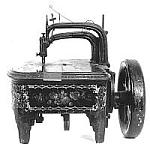


















 Singer introduced the model 206, it's first zigzag machine.
Singer introduced the model 206, it's first zigzag machine.









